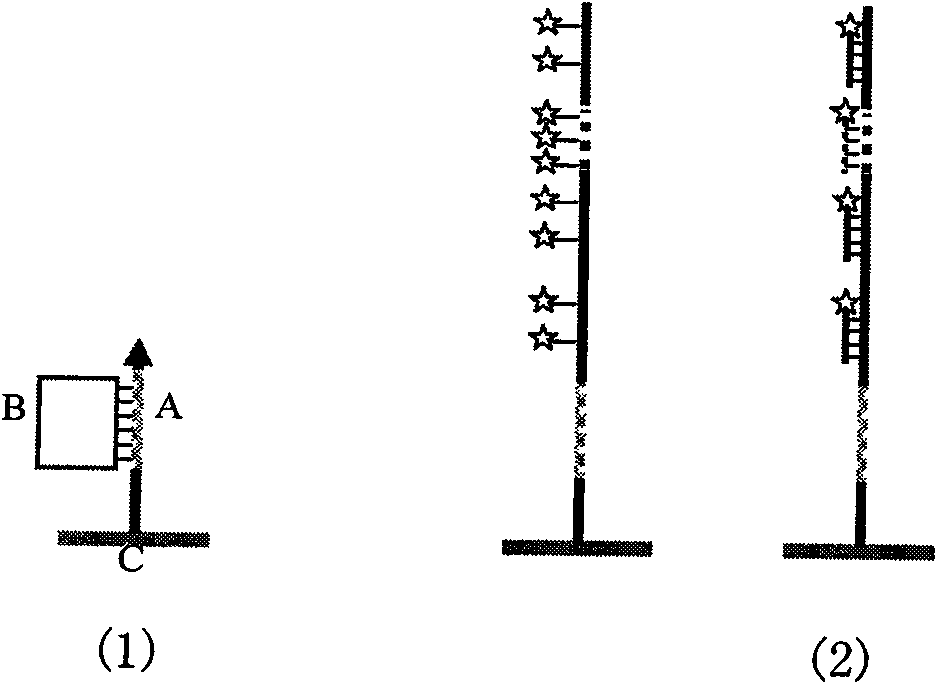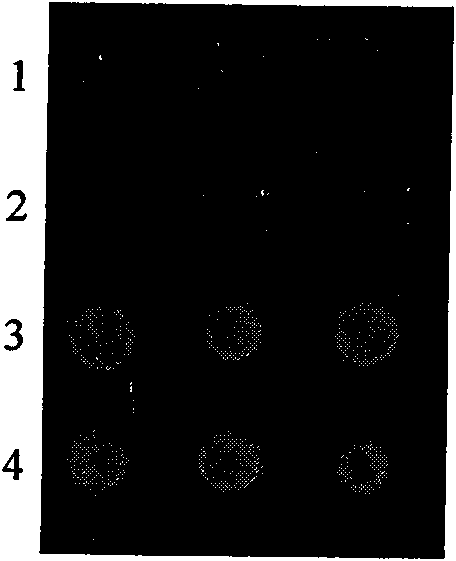High-sensitivity high-flux DNA binding protein detection method
A technology of binding protein and detection method, applied in the field of DNA binding protein detection, can solve the problems of insufficient detection sensitivity, difficulty in detection of trace samples, increase in detection cost, etc., and achieve the effects of low cost, simple preparation, and reduced test cost.
- Summary
- Abstract
- Description
- Claims
- Application Information
AI Technical Summary
Problems solved by technology
Method used
Image
Examples
Embodiment 1
[0017] Achieve the detection of NF-kappaB p50, NF-kappaB p52 and OCT-1 proteins in the crude tumor cell culture extracts of the same cancer pain-sensitive sample: it will be used to detect NF-kappaB p50, NF-kappaBp52 and OCT-1 proteins, respectively The double-stranded oligonucleotide with acrylamide modification is fixed on the polyacrylamide gel chip (with wild-type sequence and known NF-kappaB p50 sample as positive control, with mutant sequence and known NF-kappaB p50 sample As a negative control), the crude tumor cell culture extract was incubated with the chip; then the double-stranded oligonucleotide on the chip was digested with exonuclease III. After the gel chip is decontaminated by low-frequency ultrasound, the loop detection probe is hybridized with the chip, and isothermal rolling circle amplification is performed for 30 minutes. Finally, the amplification chip is hybridized with the universal fluorescent detection probe, and the data is analyzed after the chip is sca...
Embodiment 2
[0019] Achieve the detection of NF-kappaB p50, NF-kappaB p52 and OCT-1 proteins in the crude tumor cell culture extracts of the same cancer pain-sensitive sample: it will be used to detect NF-kappaB p50, NF-kappaBp52 and OCT-1 proteins, respectively The double-stranded oligonucleotide with amino modification is fixed to the aldehyde modified chip (with wild-type sequence and known NF-kappaB p50 sample as positive control, and mutant sequence and known NF-kappaBp50 sample as negative Control), the crude tumor cell culture extract was incubated with the chip; then the double-stranded oligonucleotide on the chip was digested with exonuclease III. After the gel chip is decontaminated by low-frequency ultrasound, the loop detection probe is hybridized with the chip, and isothermal rolling circle amplification is performed for 30 minutes. Finally, the amplification chip is hybridized with the universal fluorescent detection probe, and the data is analyzed after the chip is scanned. The ...
Embodiment 3
[0021] Achieve the detection of NF-kappaB p50, NF-kappaB p52 and OCT-1 proteins in the crude tumor cell culture extracts of the same cancer pain-sensitive sample: it will be used to detect NF-kappaB p50, NF-kappaBp52 and OCT-1 proteins, respectively The double strands of biotin-modified oligonucleotides are fixed to streptavidin-modified magnetic microspheres or organic microspheres (with wild-type sequence and known NF-kappaB p50 samples as positive controls, and mutant type The sequence and the known NF-kappaB p50 sample are used as a negative control), the crude tumor cell culture extract is incubated with the chip; then the double-stranded oligonucleotide on the microsphere is digested with exonuclease III. After the microspheres are decontaminated by low-frequency ultrasound, the circular detection probe is hybridized with the chip, and isothermal rolling circle amplification is performed for 30 minutes. Finally, the amplified microspheres are hybridized with universal fluore...
PUM
 Login to View More
Login to View More Abstract
Description
Claims
Application Information
 Login to View More
Login to View More - R&D
- Intellectual Property
- Life Sciences
- Materials
- Tech Scout
- Unparalleled Data Quality
- Higher Quality Content
- 60% Fewer Hallucinations
Browse by: Latest US Patents, China's latest patents, Technical Efficacy Thesaurus, Application Domain, Technology Topic, Popular Technical Reports.
© 2025 PatSnap. All rights reserved.Legal|Privacy policy|Modern Slavery Act Transparency Statement|Sitemap|About US| Contact US: help@patsnap.com


